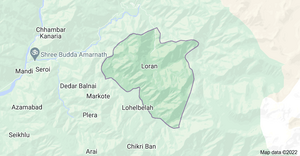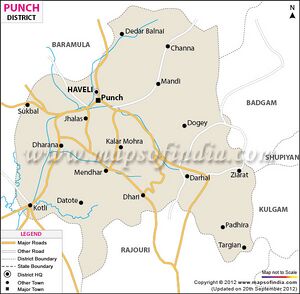Loran
| Author:Laxman Burdak, IFS (R) |


Loran (लोरन) is a village in Mandi tahsil in Poonch district of the union territory of Jammu and Kashmir, India. Loharkot or Kotta[1] of Rajatarangini has been identified with Loran () village in Mandi tahsil in Poonch district of the union territory of Jammu and Kashmir, India. [2]
Variants
Location
Loran Lower is a Village in Mandi Block in Poonch District of Jammu & Kashmir State, India. It is located 22 KM towards East from District head quarters Poonch. 5 KM from Mandi. 64 KM from State capital Srinagar, Jammu. Dana Kharappa Loran ( KM ) , Tantray Gam Loran ( KM ) , Plera ( 5 KM ) , Arai Haveli ( 7 KM ) , Arai Peeran ( 8 KM ) are the nearby Villages to Loran Lower. Loran Lower is surrounded by Surankote Block towards South , Poonch Block towards west , Tangmarg Block towards North , Bufliaz Block towards South . Punch , Baramula , Rajauri , Sopore are the near by Cities to Loran Lower. This Place is in the border of the Poonch District and Baramulla District. Baramulla District Tangmarg is North towards this place . Also it is in the Border of other district Badgam .[3]
Jat Gotras
- Lora (लोरा)
History
Loran - Loran is a small village 35 kms away from Poonch town and is situated at the foot of high mountains of Pir Panjal range and is another attraction for the tourists. Loran Nallah which flows through this beautiful village makes the place more enchanting to the eyes. Loran was once the capital of Poonch state under Hindu rulers upto 1542 A.D. It was then known as Loran-Kote. There are ruins of the Lohar Kote fort which was once called the Gateway of Kashmir.[4]
Lalitaditya had built Poonch city but at present there is no building existing on ground belonging to Lalitaditya except Ram Kund Temple Mendhar. Mr Stein who translated Rajatarangini, visited Poonch in 1892, identified a number of places like Loharkote (Loran), Attalika (Atoli), Saramber (Chamber Kanari), Savvernik (Surankote) mentioned in Rajatarangini. He could not locate Ram Kund as it was located in very remote area. Other proof is that Devadasis reported to Lalitaditya that they belonged to a nearby village known as Sover Dehmana, which is still existing near Narol, where Ram Kund Temple exists, known as Dharana instead of Dehmana.[5]
Loharkot
- For details See Loharkot/Lohara dynasty
The seat of the Lohara dynasty was a hill-fortress called Loharakotta, or Lohkot, the precise location of which has been the subject of academic debate over a prolonged period. Stein, a translator of Kalhana, has discussed some of these theories and concludes that it lay in the Pir Panjal range of mountains, on a trade route between western Punjab and Kashmir. As such, it was not itself in Kashmir but in the kingdom of Lohara, centred around a group of large villages collectively known as Lohrin, which itself was a name shared by the valley in which they were situated and a river that ran through it. The Lohara kingdom probably extended into neighbouring valleys.[6]
James Tod[7] refers to Stein[8] who has identified that Lohkot is Lohara in Kashmir.
Bhim Singh Dahiya has described about the history of Lohar clan. This clan is famous in Kashmir history and gave it a whole dynasty called Lohar dynasty. Their settlement in India was Loharin, in Pir Pantsal range. The Lohar Kot-fort of Lohars-is named after them. The famous queen Didda, married to Kshemagupta, was daughter of Lohar Kong Simha Raja, who himself was married to a daughter of Lalli (Jat Clan) Sahi king Bhima of Kabul and Udabhanda (Und, near modern Attock).
Thus Didda was a Lohariya Jat scion, and a granddaughter of Lalli Jats of Kabul baseless called Brahmans. The descendants of their ruling family are still called Sahi Jats.
Queen Didda, made one Sangram Raj, her successor. He was the son of her brother Udaya Raj and he died on 1028 A.D. [9] Lohar itself remained with Vigrah Raj. [10]
Tourism
External links
References
- ↑ Book VIII (i) p.141, 146, 151, 158, 159, 160, 161, 170, 171, 174, 176, 177, 179; Kings of Kashmira Vol 2 (Rajatarangini of Kalhana)/Book VIII (ii) p.229, 245, 247, 252
- ↑ Kashmir Paradise, 29.3.2009
- ↑ http://www.onefivenine.com/india/villages/Poonch/Mandi/Loran-Lower
- ↑ https://poonch.nic.in/places-of-interest/
- ↑ Kashmir Paradise, 29.3.2009
- ↑ Stein, Mark Aurel (1989) [1900]. Kalhana's Rajatarangini: a chronicle of the kings of Kasmir, Volume 2 (Reprinted ed.). Motilal Banarsidass. ISBN 978-81-208-0370-1, pp. 293-294.
- ↑ James Todd Annals/Chapter 7 Catalogue of the Thirty Six Royal Races ,p. 116, fn-2
- ↑ Stein, Rajatarangini, i. Introd. 108, ii. 293 ff.
- ↑ RAJAT, VI, 355 and VII, 1284
- ↑ For details see, RAJAT, Vol II, p. 293; Steins note.

